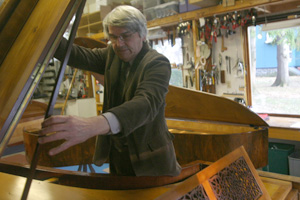A mop of white hair and the smiling face of Ed Swenson pop out from underneath a caramel-colored piano. The professor of music theory, history and composition lies face-up on the ground as he beats on the underside of the instrument, replicating the sound that a fifth pedal used to make.

The bass drum vibration reverberates through the room with each hit, in a sound characteristic to the 1825 Austrian soundboard made of fine-grain spruce panels.
“I’ve been working on this piano for about 10 years,” Swenson said.
Watch Ed Swenson talk about the art of piano restoration.
Swenson spends most of his free time working on pianos in his shop in the back of his Trumansburg house. He restores modern, historic and fortepianos from all throughout the world. Most take him about a year, but others take longer, as he puts his job at Ithaca College first.
He tinkers with the pianos delicately, as they are all centuries old. Furnace piping hanging from the ceiling, a dehumidifier in the corner and a temperature gauge on the wall keep the moisture level at 50 percent to prevent the wooden pianos from expanding and contracting.
His shelves support a collection of coiled brass wire for restringing, hitch pins, giant clamps and a lifetime supply of animal hide glue — the only adhesive he sees fit for repairing these vintage instruments. He rebuilds carefully enough to prevent diminishing the original parts, seeking out the appropriate wool cloths, woods and leather to make the pianos play again.
Swenson sets himself apart from other restorers by his willingness to investigate each condition. Longtime friend and piano pioneer Malcolm Bilson only goes to Swenson.
“When I have a [piano] problem, I call him first,” Bilson said. “He is the best in the country.”
The recognized restorer started his musical career as a trombonist at Oberlin College, where he made the last-minute decision to get a piano technology certificate his senior year. His summer job at Lyon & Healy in Chicago catapulted an interest in restoring pianos.
Early opportunities like performing with Igor Stravinsky in the Oberlin Orchestra and fine-tuning Ray Charles’ piano helped his résumé. Years later, the pianos he restored have ended up in the houses of wealthy buyers and early-century music lovers, as well as in museums like the Smithsonian Institute in Washington, D.C., and the Nippon Cultural Center in Tokyo.
Swenson has always had a tendency for tuning, even beyond pianos. He restored his first car, a Ford Model A, in high school and his federal-style colonial house in Trumansburg when he first moved there 30 years ago.
Now, he has 15 pianos, but most are in storage. At the request of his wife Maria, he keeps only one at home.
“There have been some very loud memories in that house,” Swenson said.
Swenson spent spring break visiting family in Alberta, Canada, and a client in Italy whose inheritance included a rare early 19th-century piano built by the same person who built Beethoven’s last piano.
Sophomore Rob Yaple, one of Swenson’s students, said he never knows where Swenson will be next.
“He’s a music teacher by day, superhero by night,” Yaple said.
In classes, Swenson is just as meticulous as he is with his pianos. He goes to great lengths to help students, whether it’s with a musical collaboration in class or Italian homework.
His lectures are jam-packed with personal narratives from his worldly travels and experiences teaching at the college for the past 40 years. While getting his Ph.D. in 1967, Swenson was asked to teach his first class at the college, Bibliography and Research in Music. Steve Brown, now a professor of music performance, was one of his first students.
“He was a mentor to me when I was younger,” Brown said. “I am very proud to be working with him.”
Sophomore Anna Halperin said even though the material covered in Swenson’s history classes can be daunting, he always tries to make it interesting.
“His passion for the subject translates to the students,” Halperin said.
This semester, Swenson teaches three music history classes and another class on historical music figures. Swenson understands most music students would rather perform, but he said the history courses he teaches can still be engaging.
“Knowing the history of your profession is a bit like knowing the roots of your own family,” he said.
Swenson wants to teach, as well as restore pianos for international clients and friends like Bilson, for as long as he can. When he does retire, he hopes to spend the winters with his wife in Italy. For the rest of the year, he plans to continue restoring historic pianos at his shop in Ithaca.
“It’s an area where you always feel a bit like a beginner,” he said. “There are always so many things to learn.”




